
Barberton is a city in Summit County, Ohio, United States. The population was 25,191 at the 2020 census. Located directly southwest of Akron, it is a suburb of the Akron metropolitan area.
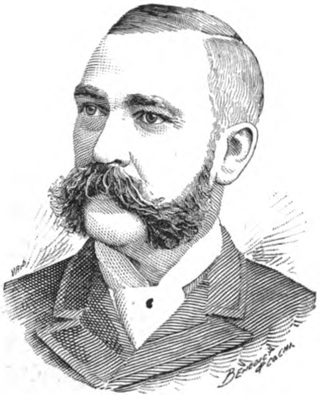
Ohio Columbus Barber was an American businessman, industrialist and philanthropist. He was called "America's Match King" because of his controlling interest in the Diamond Match Company, which had 85 percent of the market in 1881. He founded the city of Barberton, Ohio in 1891 and moved his manufacturing plant there in 1894. It produced 250 million matches per day. He also founded the Akron City Hospital.

Lake Anna Park is a 21-acre (85,000 m2) park around a spring-fed, 10-acre (40,000 m2) lake, and is located in the center of downtown Barberton, Ohio.
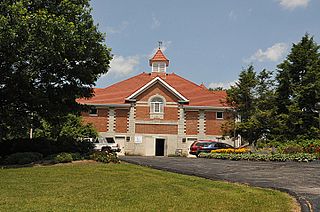
The Anna–Dean Farm is a historic farm in Barberton, Ohio, United States. It is listed on the National Register of Historic Places and is the site of several structures independently listed on the Register.

Hunting Lodge Farm is a historic house located near Oxford in Oxford Township, Butler County, Ohio, United States. Constructed as a hunting lodge, it has been used by multiple prominent local residents, and its distinctive architecture has made it worthy of designation as a historic site.

The John Scott Farm is a historic farmstead near the community of Shandon, Ohio, United States. Established in the nineteenth century and still in operation in the twenty-first, the farmstead has been named a historic site because of its traditionally built agricultural structures.

The O. C. Barber Barn No. 1, built in 1909, is an historic farm building located on the Anna-Dean Farm in Barberton, Ohio. It was built by American businessman and industrialist Ohio Columbus Barber, the developer of both Barberton, which he envisioned as a planned industrial community, and the nearby 3,500-acre (14 km²) Anna-Dean Farm, which he envisioned as a prototype for modern agricultural enterprise. Barber was called America's Match King because of his controlling interest in the Diamond Match Company.

The O. C. Barber Colt Barn, built in 1912, is an historic farm building located on Austin Drive on the Anna-Dean Farm in Barberton, Ohio. It was built by American businessman and industrialist Ohio Columbus Barber, the developer of both Barberton, which he envisioned as a planned industrial community, and the nearby 3,500-acre (14 km2) Anna-Dean Farm, which he envisioned as a prototype for modern agricultural enterprise. Barber was called America's Match King because of his controlling interest in the Diamond Match Company.
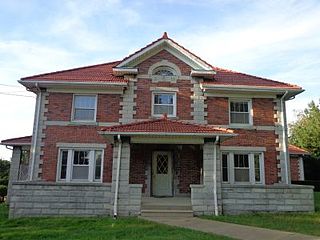
The O. C. Barber Creamery, built in 1909, is an historic farm building located at 365 Portsmouth Avenue on the Anna-Dean Farm in Barberton, Ohio. It was built by American businessman and industrialist Ohio Columbus Barber, the developer of both Barberton, which he envisioned as a planned industrial community, and the nearby 3,500-acre (14 km²) Anna-Dean Farm, which he envisioned as a prototype for modern agricultural enterprise. Barber was called America's Match King because of his controlling interest in the Diamond Match Company.
The O. C. Barber Machine Barn, also called the Implement House. built in 1911, is an historic farm building located on Austin Drive on the Anna-Dean Farm in Barberton, Ohio. It was built by American businessman and industrialist Ohio Columbus Barber, the developer of both Barberton, which he envisioned as a planned industrial community, and the nearby 3,500-acre (14 km²) Anna-Dean Farm, which he envisioned as a prototype for modern agricultural enterprise. Barber was called America's Match King because of his controlling interest in the Diamond Match Company.
Barber House, Barber Farm, or Barber Barn may refer to:

The Martin Marmon House is a historic house near the village of Zanesfield in Jefferson Township, Logan County, Ohio, United States. Built by pioneer settler Martin Marmon around the year 1820, it is one of the best remaining examples of Quaker architecture in the area.

First Presbyterian Church is a Presbyterian church in the city of Napoleon, Ohio, United States. Located at 303 W. Washington Street, it has been recognized as a historic site because of its unusual architecture.
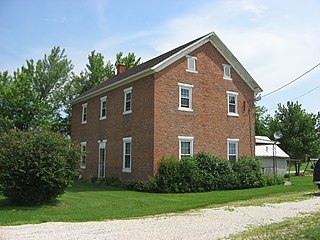
The Gruenwald Convent is a historic former Roman Catholic convent in the far western part of the U.S. state of Ohio. Located approximately 0.5 miles (0.80 km) south of the small community of Cassella in Mercer County, the convent was built in 1854. It is one of six convents that were built by the Missionaries of the Precious Blood in this portion of Ohio and in adjacent portions of far eastern Indiana, and one of only two that remain without significant alterations.

The Perkins Stone Mansion is a historic house museum in Akron, Ohio, United States.
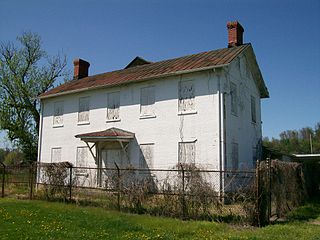
The Judge Joseph Barker House is a historic residence in southern Washington County, Ohio, United States. Located along State Route 7 southwest of the community of Newport, it is a brick structure with a roof of metal, a foundation of sandstone, and other elements of wood and metal. Constructed in 1832, it is a two-story rectangular building that sits atop an Ohio River bluff. Its floor plan is five bays wide, featuring a central entrance with a fanlight and sidelights.

Glendale Cemetery is a historic rural cemetery located in Akron, Ohio. It was added to the National Register of Historic Places in 2001.
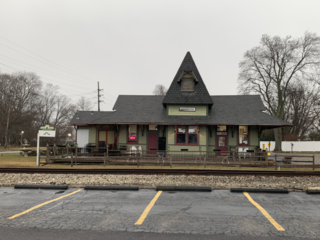
Barberton was a train station along the Erie Railroad main line in the city of Barberton, Summit County, Ohio, United States. Located 612.8 miles (986.2 km) from Hoboken Terminal on the Kent Division of the main line, the station first saw service in 1890 while under the ownership of the New York, Pennsylvania and Ohio Railroad, a subsidiary of the Erie Railroad, to help bring people to the new community. Passenger service was terminated on August 1, 1965, with the cancellation of the Atlantic Express (eastbound) Pacific Express (westbound), and multi-day trains from Hoboken to Dearborn Station in Chicago, Illinois.
Fenn Farm is a historic property on Case Street in Middlebury, Vermont. Developed c. 1828 as a sheep farm but now diversified, it now includes a well-preserved collection of mid-19th century farm buildings. It was listed on the National Register of Historic Places in 1995.

Arthur Oswin Austin was an American electrical engineer and inventor. A native of California, he lived for a few years in New York where he worked for General Electric and the Lima Insulator Company, but spent most of his adult life in Ohio where he married, worked for the Ohio Brass Company and founded the Austin Insulator Company. He bought a large estate in Barberton, Ohio, lived in the mansion, and built an extensive outdoor electrical laboratory on the grounds.



















